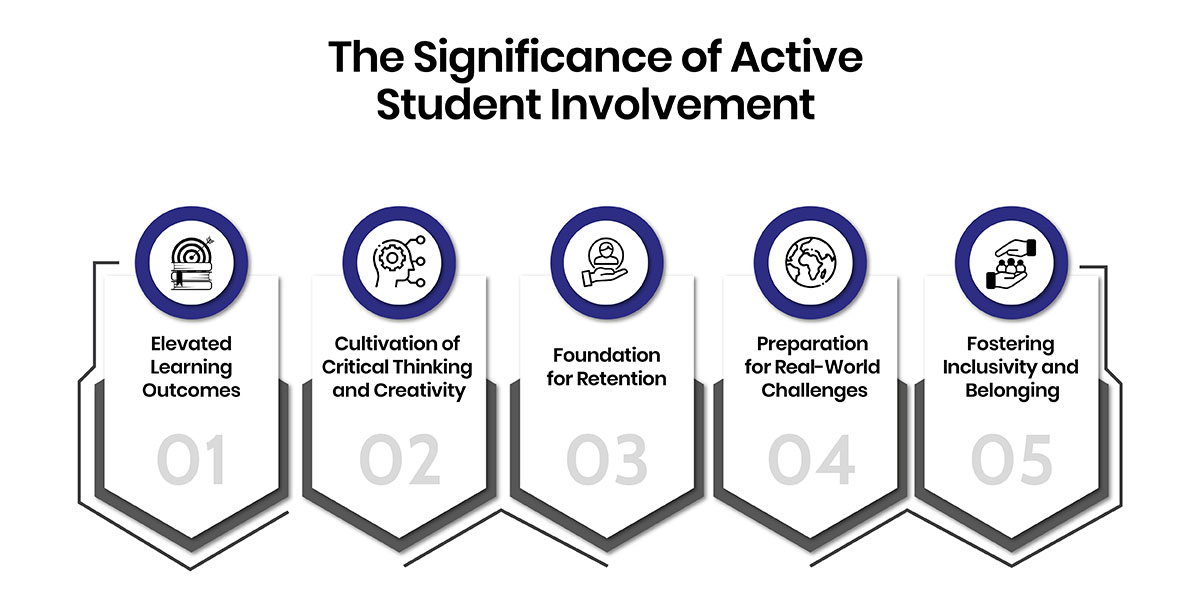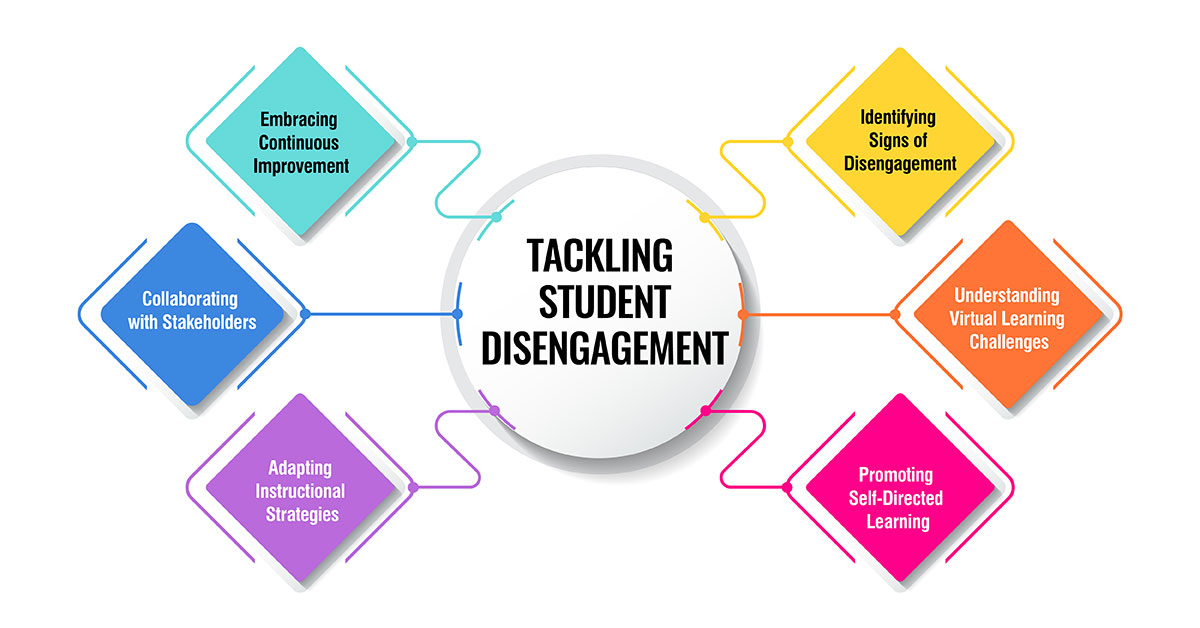Increased Student Engagement: Elevating Academic Performance
June 07, 2024In the pursuit of academic excellence, fostering robust student engagement is paramount. Whether in K-12 schools or higher education institutions, engaged students demonstrate a firm commitment to learning, resulting in improved achievement, persistence, and retention. However, in today's educational landscape, sustaining high levels of engagement can be challenging, particularly with the shift to virtual learning environments.
Despite the challenges posed by virtual learning environments, educators strive to overcome impediments and create dynamic learning environments where students are actively involved in their education. By recognizing the importance of student engagement and implementing effective strategies, educational institutions can pave the way for academic success and holistic development among students.
Comprehending Student Engagement
Student engagement is the heartbeat of effective education, overstepping passive participation to ignite a profound connection between learners and their academic journey. Defined as the energy and effort students invest in their learning community, it encompasses a spectrum of behaviors, cognitions, and emotions.
It refers to the degree of attention, interest, curiosity, and passion that students show when they are learning or participating in educational activities. It involves not only being physically present in the classroom but also being mentally and emotionally invested in the learning experience.
Student engagement surpasses conventional metrics of achievement, bringing in holistic development and intellectual curiosity. Academic excellence, far from being confined to test scores, embodies a profound understanding of concepts, nurtured through critical thinking and an intense passion for knowledge.
In this paradigm, education evolves from a mere transmission of information to an ecosystem where curiosity grows, and learning becomes joyous. It beckons students to question incessantly and actively participate in shaping their educational journey. Beyond the confines of traditional classrooms, it develops an environment where every interaction, every experience, becomes a stepping stone towards intellectual growth.
The Significance of Active Student Involvement
Active student involvement is where students are not merely passive recipients of information instead are actively engaged in the learning process. This engagement holds profound significance across various dimensions of academic and personal growth.

-
01. Elevated Learning Outcomes:
Through discussions, analysis, and hands-on projects, students delve deep into the subject matter, making connections and grasping concepts with greater clarity. This depth of engagement leads to heightened comprehension, retention, and application of knowledge, ultimately amplifying academic performance. -
02. Cultivation of Critical Thinking and Creativity:
Engagement ignites the spark of critical thinking and creativity. When students are encouraged to question, debate, and explore ideas, they develop the ability to dissect complex issues and generate innovative solutions. -
03. Foundation for Retention:
Students who are deeply engaged are more likely to stay committed to their studies, complete their educational journey, and actively contribute to their learning community. This sense of connection directly impacts retention rates, ensuring that students remain invested in their education over the long term. -
04. Preparation for Real-World Challenges:
Collaborative problem-solving, effective communication, and the ability to tackle complex issues are hallmarks of engaged learners. By honing these skills in the classroom, students are better prepared to navigate the complexities of the real world, thriving in diverse professional and personal contexts. -
05: Fostering Inclusivity and Belonging:
When educators prioritize engagement strategies that support learners with different backgrounds, abilities, and identities, it creates a classroom environment where everyone feels valued and respected. This inclusive approach not only enhances the learning experience but also contributes to a more equitable and supportive educational community.
Ways to Build Student Engagement for Academic Excellence
Building student engagement is foundational to achieving academic excellence. By incorporating a diverse range of effective strategies, educators can create lively learning environments that promote active participation leading to better student outcomes.
Here are key approaches to promote student engagement for academic excellence:
-
1. Empowering through Open-ended Questions:
Encourage deep thinking and discussion by posing open-ended questions that invite students to explore diverse perspectives and justify their opinions. This approach cultivates critical thinking and stimulates meaningful discourse, enhancing understanding and engagement. -
2. Leveraging Prior Knowledge:
Assess students' existing knowledge before instruction to tailor teaching methods effectively. By building on what students already know, educators can create connections, generate interest, and lay a solid foundation for deeper engagement. -
3. Ungraded Assignments for Accountability:
Implement ungraded assignments that encourage active participation and reflection without the pressure of grades. These assignments hold students accountable for their learning journey while aiding intrinsic motivation and a growth mindset. -
4. Cultivating Collaborative Learning and Teaching:
Promote collaborative learning environments where students work together, share expertise, and learn from one another. By incorporating peer teaching and group activities, educators build a sense of community and collective responsibility for learning outcomes. -
5. Championing Student Explainers:
Recognize and empower students who demonstrate understanding by inviting them to explain concepts to their peers. This not only reinforces their own comprehension but also promotes peer learning and engagement. -
6. Leveraging Peer Review for Growth:
Integrate peer review into assignments to encourage critical analysis and constructive feedback exchange among students. Establishing clear review norms promotes accountability and supports continuous improvement. -
7. Multifaceted Approach to Learning:
Recognize and accommodate diverse learning preferences by offering multiple avenues for engagement, including various sources, modalities, and learning activities. This inclusive approach respects individual differences and enriches the learning experience for all students. -
8. Cultivating Reflection for Metacognition:
Encourage metacognitive skills development through reflective practices such as self-assessment and exit tickets. By prompting students to evaluate their learning process and set goals for improvement, educators promote self-awareness and agency in their academic journey. -
9. Prioritize Student Autonomy and Offer Consistent Feedback:
Empower students by providing opportunities for autonomy in their learning journey, allowing them to take ownership of their academic pursuits. Offer regular, constructive feedback on assignments and assessments to guide student progress and encourage continuous improvement. Build a culture of collaboration where feedback is viewed as a catalyst for growth rather than criticism. -
10. Embrace Technology and Celebrate Diversity:
Leverage multimedia presentations, interactive platforms, and online resources to cater to varied learning preferences and promote active participation. Create inclusive learning environments where every student feels represented, respected, and empowered to contribute. -
11. Cultivate Curiosity and Promote Leadership:
Provide opportunities for students to pursue their interests, engage in independent research, and pursue creative projects. Promote student leadership and initiative by empowering students to take on leadership roles, initiate projects, and contribute to decision-making processes. -
12. Offer Goal-setting and Encourage Failure as a Learning Opportunity:
Emphasize the value of resilience and perseverance in the face of challenges and encourage students to view failure as a natural part of the learning process. Create a safe and supportive environment where students feel empowered to take risks, experiment, and learn from setbacks.
Tackling Student Disengagement
As education evolves, so too do the challenges associated with student engagement, particularly in the field of virtual learning. Recognizing the signs of disengagement early on is crucial for educators to intervene effectively.

-
Identifying Signs of Disengagement:
Absenteeism, behavioral changes, diminished participation, and waning interest in coursework serve as red flags signaling potential disengagement. These indicators highlight the need for intervention to address underlying issues and reignite student involvement. -
Understanding Virtual Learning Challenges:
Transitioning to virtual learning presents obstacles for students, including unfamiliarity with technology, the need to develop self-discipline and adapt to deferred gratification. Instructors also face their own learning curve, needing to refine online teaching skills and redesign teaching methods. -
Promoting Self-Directed Learning:
Encouraging self-directed learning practices, such as goal-setting and independent inquiry, creates autonomy and accountability. Providing resources and support to help students navigate learning environments equips them with the skills and confidence needed to succeed. -
Adapting Instructional Strategies:
Adapting Instructional Strategies may involve incorporating interactive activities and real-world applications to enhance engagement and relevance. Additionally, providing timely feedback and personalized support ensures that students feel valued and supported in their academic endeavors. -
Collaborating with Stakeholders:
Tackling student disengagement requires collaboration among educators, students, parents, and administrators. Establishing open lines of communication and nurturing a supportive learning community enables stakeholders to identify challenges and work together to implement effective solutions. -
Embracing Continuous Improvement:
Embracing a mindset of continuous improvement allows educators to evolve their practices and meet the needs of students in learning environments. By involving innovation, reflection, and collaboration, educators can create captivating learning experiences that inspire students to expand academically and beyond.
Here Are Few Signs of Student Disengagement:
- 1. Non-attendance of Classes: When students consistently miss scheduled classes, it suggests a lack of interest in participating in academic activities.
- 2. Avoidance of Coursework: Students who actively avoid completing assigned coursework demonstrate a diminishing commitment.
- 3. Behavioral Changes: Noticeable shifts in behavior, such as withdrawal from interactions or decreased participation as well as disruptive behaviors.
- 4. Declining Interest in Studies: A lack of enthusiasm toward studying and engaging with course materials.
- 5. Reluctance to Participate in Discussions: Students who show reluctance to engage in class discussions.
- 6. Tardiness to Classes: Frequent lateness to classes suggests a casual attitude toward punctuality and may indicate a lack of commitment.
- 7. Quick Surrender to Challenges: Students who readily give up on challenging tasks without applying effort.
- 8. Boredom or Distraction: Students who appear disinterested or bored during class sessions.
Recognizing these indications of disengagement allows educators to intervene effectively and support students in reestablishing their connection to the learning process.
Conclusion
Student engagement is fundamental to achieving academic excellence and promoting overall development. By implementing diverse strategies to cultivate active participation, educators can create learning environments that creates a passion for learning. However, in the face of challenges, addressing signs of student disengagement becomes essential. Ultimately, by prioritizing student engagement, educators pave the way for a transformative educational experience that empowers students to reach their full potential.




